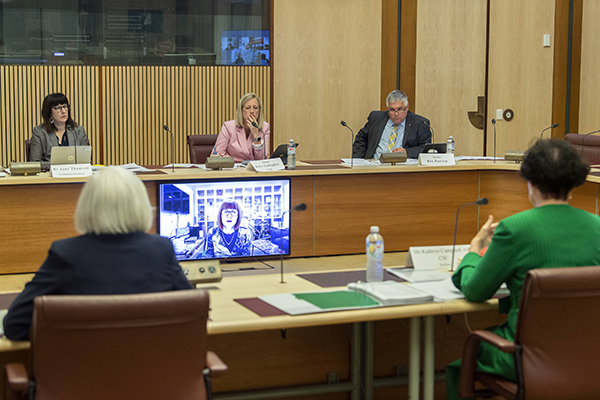Legislation committees
Legislation committees have a number of functions:
1. Consideration of proposed government expenditure
Legislation committees inquire into and report upon the government’s budget proposals (estimates of expenditures) referred to them by the Senate. These estimates are contained in the main appropriation bills introduced into Parliament as part of the Budget in May (budget estimates), and in the additional appropriation bills introduced in February (additional estimates).
Public hearings are held at which the relevant Senate ministers, together with senior officials from the organisations whose estimates are being examined, appear before the committees to explain expenditure proposals and to answer questions concerning the effectiveness and efficiency of various programs. An observer from the Department of Finance also attends each committee hearing.
The committees work to a very tight timetable. Each committee is allocated four days to conduct hearings during budget estimates and two days or more to consider additional estimates. When information is not provided during a hearing, the committee sets a date by which that information is required.
Supplementary hearings may be held after consideration of budget estimates. Senators must give three days’ notice of any matter relating to the proposed expenditure they wish to discuss at the supplementary hearings.
Once committees have completed their consideration of the estimates expenditure they report their deliberations to the Senate.
Consideration of estimates is regarded by senators as among the most valuable of the Senate’s activities. The former Leader of the Opposition in the Senate, the Hon. Senator John Faulkner, has described the process as the ‘best accountability mechanism of any Australian parliament’.
For more information on the consideration of estimates see Senate Brief No. 5, Consideration of Estimates by the Senate’s Legislation Committees.

Senators Katy Gallagher (Chair), Rex Patrick and Rachel Siewert (via video) question witnesses during a hearing of the Select Committee on COVID-19. The Committee Secretary is on Senator Gallagher's right
2. Consideration of legislation
Committees also inquire into and report on any bills or draft bills referred to them.
Until 1990 the Senate referred bills to committees on an ad hoc basis. New procedures adopted in 1989 and commenced in 1990 saw the establishment of a systemic referral of bills to legislative and general purpose standing committees by the Selection of Bills Committee (see Domestic committees above). Since then, there has been a substantial increase in the number of bills referred to standing committees. In the years 1970 to 1989 the Senate referred 55 bills to committees for consideration. Between 1990 and 2019, 2416 bills were referred to committees, including 70 in 2021.
Some bills may require consideration only from a technical point of view while others may need to be examined in terms of their substance and impact. Committees endeavour to seek evidence from a wide range of witnesses in the time available, both by receiving written submissions and by oral evidence. The committees meet in public to hear evidence from the appropriate minister and officials, and usually a number of independent experts or representatives of organisations affected by the bill. Often these hearings are held at various locations around Australia relevant to the subject matter of the bill.
The practice of routinely referring bills to committees has given Senate committees a greater role in the consideration of legislation. A committee has no power to amend a bill referred to it, but it may recommend amendments or it may advise the Senate to agree to the bill without changes.
3. Consideration of annual reports and examination of government administration
Standing order 25(20) orders committees to monitor the performance of government departments and agencies allocated to them, by examining their annual reports.
The committees are required to report to the Senate on whether the annual reports are satisfactory, to investigate any matters requiring closer scrutiny, and to monitor whether annual reports are received on time. Committees also report to the Senate if an agency fails to present its annual report. Annual reports of departments and agencies may also be considered by committees in conjunction with their examination of estimates.
Committees may also report on the performance of departments and agencies allocated to them.